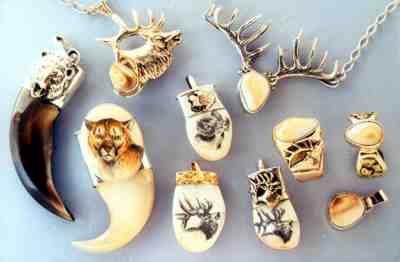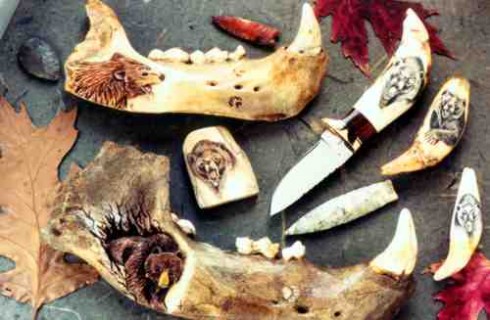Article by Marcia Darnell
Local Artists – December 2005 – Colorado Central Magazine
WHAT DO YOU CALL a scrimshaw artist? A scrimshander. What do you call a scrimshander who specializes in elk antler? Tom High.
High, a third-generation native of the San Luis Valley, grew up in Alamosa but hit the road after high school.

“After I graduated I had six different art scholarships,” he says. “I spent exactly two days in college, then I walked out and went to Alaska.”
He arrived shortly after the big earthquake in 1964, and became the first person to drive the Talkeetna Highway.
Pioneer spirit is in his blood. High’s grandfather came to the Valley from Italy in 1918 and became a cattle rancher, so High had a skill to pay his way on his travels. He traversed the United States, punching cattle and training horses along the way. He met his wife, Mary, in upstate New York and the two have been spouses and business partners for 37 years.
“She’s management and I’m labor,” he says.
A bad experience with a gallery in Taos years ago taught High that art is a business, and business requires good management.
High’s father, a Kiowa, died when he was young, and High entertained himself while his mother worked by drawing on grocery bags.
“I’ve been an artist since I was born,” he says. “I’ve been drawing as long as I can remember, and am basically self-taught in all my art endeavors, including scrimshaw.”
In Alaska, High worked as a guide, taxidermist’s assistant and horse wrangler. He first saw native Inuit scrimshaw there.
“Scrimshaw was started by the early American whalers,” he says. “They were on long trips — two-year voyages weren’t unheard of — and they’d get bored. So the sailors started inscribing designs on whale teeth, using the needles they had to repair the sails. They used soot from their oil lamps to color their designs.
“Those whalers taught scrimshaw to the Alaskan natives.”
The Alaskan Inuit work with the traditional whale teeth, but also with walrus tusks. High is one of about 25 scrimshanders in the U.S. who work at their craft full time. He’s known internationally for specializing in elk ivory. He is also known for pioneering the use of colors in his artwork, which historically is black and white.
“I use fine art oils for that,” High says.
High’s pieces are both durable and delicate. Teeth, canines, claws, antler, and horns often outlast the rest of an animal’s body, and the intricate pictures and designs combined with the tough material make unique tributes to nature.
HIGH CREATES ART and jewelry made from deer and elk antlers, bear canines, and fossils. He’s also used hippo teeth, cougar canines, and caribou and moose antlers. One of his most interesting pieces is a prehistoric cave bear jawbone depicting a bear emerging from a cave and carved bear tracks. Another is a mastodon tusk.
“On the inside of it, you can see the tiny marks where a prehistoric mouse gnawed on it,” High says of this piece, “so along with the saber toothed tiger, I’m going to add a tiny picture of a mouse to it.”

He creates custom works using elk ivory and claws sent to him by hunters, as souvenirs of their kills. As part of his work he’s become a skilled, self-taught, goldsmith and silversmith. High also hand-builds knives with scrimshaw art on the elk antler handles. His knives are in such demand that there’s a several-year backlog of orders.
“I make the knives as tools, not art,” he says. “But they look nice, too.
“I do it all.”
Many collectors around the world buy his knives.
High shows his work regionally at shows and galleries in Aspen, Taos, Santa Fe, Estes Park, and Jackson Hole, and has items in galleries around the U.S. and in Australia. He travels to wildlife shows around the country and will be in Nashville, Charleston, and Louisville, Kentucky, this winter. Locally, he shows at the Monte Vista Crane Festival every spring with his daughters, Sherita and Shaleah. The women are now in their 20s and are both jewelry designers. He collaborates on some of their work.
“I have ideas that will outlast my lifetime,” High says.
High’s personal philosophy is rooted in his Native American ancestry, his Jehovah’s Witness faith, and his life in Colorado. He sees his work as a way to honor wildlife and the outdoors in keeping with that philosophy.
He, Mary, and their daughters spend every September in the mountains. They’re bowhunters and their autumn kills provide their family’s meat through the winter. They try to use all parts of the animal, whether for food, clothing, or artwork.
They travel to Michigan every fall to harvest fruit and vegetables, and to be inspired by the beautiful Eastern fall colors, which they plan to incorporate into a new line of jewelry. Their modest house is heated with wood, and their lifestyle keeps their cash needs low.
“Keep life simple,” High says.
LIVING IN THE SAN LUIS VALLEY is a big part of that lifestyle. High and his family have strong ties to the region. In fact, Mary’s parents visited a year after the Highs married, and soon moved from New York to the Valley because they loved it too.
“Growing up here, there wasn’t a lot to do,” High says, “but I’ve never been bored.
“There’s a huge wealth of inspiration to use in the Valley,” he says. “I probably wouldn’t be an artist anywhere else.”
For now, showings are by appointment only. Tom and Mary High are planning to build a separate gallery on the family spread near Alamosa.
“Our artistry supplies us with our needs and I look forward to getting up and working in my studio every day,” High says. “Few people today can say they enjoy their work.”
“It keeps us going and feeds the family,” High says.
To arrange to view Tom High’s art, call Rocky Mountain Scrimshaw at 719-589-2108, or check www.rockymountainscrimshaw.com
Marcia Darnell lives, writes, and appreciates art in the San Luis Valley.


